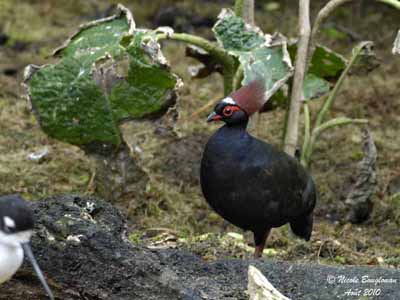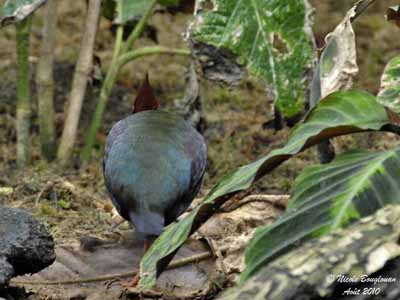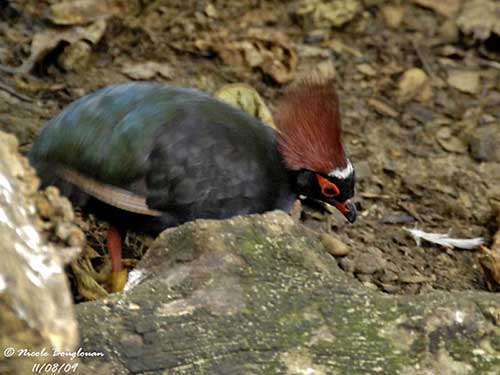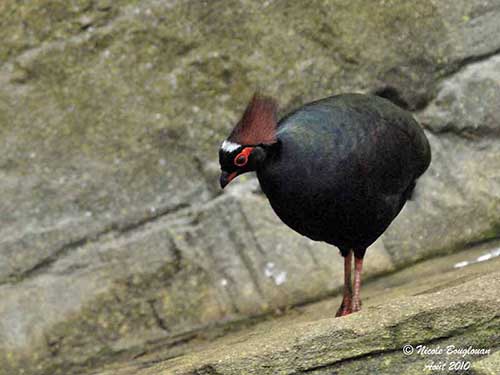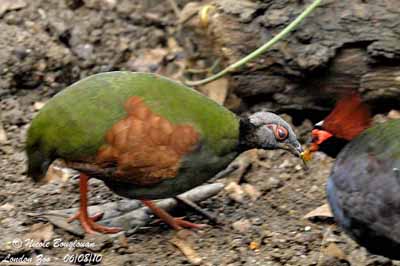
Fr: Rouloul couronné
All : Strausswachtel
Esp: Perdiz Rulrul
Ital: Rulrul
Nd: Gekuifde Bospatrijs
Photographer:
Nicole Bouglouan
PHOTOGRAPHIC RAMBLE
Texte de Nicole Bouglouan
Sources:
HANDBOOK OF THE BIRDS OF THE WORLD Vol 2 by Josep del Hoyo-Andrew Elliot-Jordi Sargatal - Lynx Edicions - ISBN: 8487334156
PHEASANTS, PARTRIDGES AND GROUSES – By Steve Madge and Phil Mc Gowan – Helm Identification Guides. ISBN: 0713639660
Hennache, A. & Ottaviani, M. (2011). Cailles, Perdrix et Francolins de l'Ancien Monde, 400 pages. Editions W.P.A. France, Clères, France. ISBN 978-2-9512467-3-7
Hennache, A. & Ottaviani, M. (2005). Monographie des faisans, volume 1. Edition W.P.A. France, Clères, France. ISBN: 2-9512467-1-4
Hennache, A. & Ottaviani, M. (2006). Monographie des faisans, volume 2. Edition W.P.A. France, Clères, France.ISBN: 2-9512467-2-2
"Les auteurs renoncent à leurs droits d'auteurs pour que la vente de cet ouvrage, publié par la World Pheasant Association, soit destinée à soutenir des projets de conservation."
Wikipedia (Wikipedia, The Free Encyclopedia)
Crested Partridge
Rollulus rouloul
Galliforme Order – Phasianidae Family
BIOMETRICS:
Length: 26 cm
Weight: M: 232 g – F: 200 g
DESCRIPTION:
More often seen in zoos than in wild, the Crested Partridge is classified as NEAR THREATENED. Only member of genus “rollulus”, this partridge is very attractive and elegant.
Adult male has glossy dark blue-black plumage. Back and uppertail coverts are metallic green. The rounded wings are dark brown, but the primary flight feathers show white outer webs. The short tail is blackish.
Underparts are dark blue-black too.
Head is black, with white forecrown from where several elongated black bristles are starting. On the crown we can see a conspicuous brushy, bright chestnut-reddish crest.
The bill is black with red patch over the gape of the upper mandible, and on the half of the lower mandible, close to the bill base.
Eyes are dark brown, surrounded by broad eye-ring. We can also see a red triangle of bare skin on the rear part of the eye.
Legs and feet are bright red. There is not claw to the hind toe, and it lacks the spur on the rear of the leg.
Female has olive-green plumage, with chestnut-brown scapulars and wings. The head is slate-grey. She lacks the brushy crest, but she has the long bristles on the grey forehead. The eyes are surrounded by the same red eye-ring, but the bare red triangle is much more reduced than in male. The bill is black and lacks red patches.
Immature is duller than female and mottled above. The bare skin around the eye is duller too.
The immature male has greyish belly.
VOICE: SOUNDS BY XENO-CANTO
The Crested Partridges are usually seen in coveys of several birds, and are known to give contact calls. If they are separated, they re-establish the contact by uttering rally calls.
The song is a monotonous series of whistles “si-ul”, with higher second note. This song is usually given in the early morning and in late afternoon.
HABITAT:
The Crested Partridge frequents the lowland rainforest, and is mainly seen in plains and hill slopes, but sometimes up to 1200 metres of elevation according to the range.
RANGE:
The Crested Partridge breeds in S Burma, S Thailand, Malaysia, Sumatra and Borneo.

BEHAVIOUR:
The Crested Partridge feeds on seeds, fruits, various insects and small molluscs. They often forage in pairs, close to each other. The female follows the male. They keep contact thanks to the soft whistles.
They feed by scratching and picking in the leaf litter, searching for food. They may feed close to wild pigs, and often forage below the fruiting trees, taking discarded fragments of fruits dropped by arboreal monkeys and birds.
The Crested Partridge is also frequently seen in group of up to 15 birds of both sexes and various ages.
With its strong legs well adapted to the ground, this partridge walks rapidly in jerky fashion. It prefers to walk or run rather than fly to escape some danger. If necessary, it flies low and over short distance to reach the cover protection.
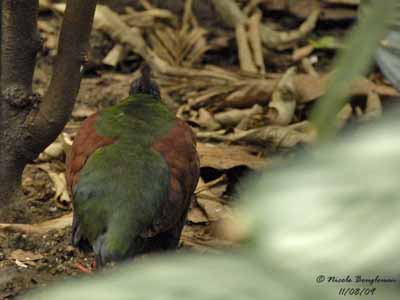
They roost in family groups a few metres above the ground, in bushes or small trees.
The Crested Partridge seems to be resident breeder in its range.
FLIGHT:
The Crested Partridge prefers to run rather than fly to escape a danger. This terrestrial bird has rounded wings that it uses almost only to go to the roost.
REPRODUCTION:
Breeding season varies according to the range.
The Crested Partridge is monogamous. The nest is a scrape on the ground on the forest floor, often hidden beneath a loose heap of dead leaves through which the adults digs a kind of burrow. This type of nest is very well camouflaged and difficult to find if the birds are motionless.
The female lays 5-6 white eggs. Incubation lasts about 18-19 days (in captivity), and by female alone.
Chicks are fed by both parents bill to bill. They are precocial but they sleep at night in the nest, even while small.
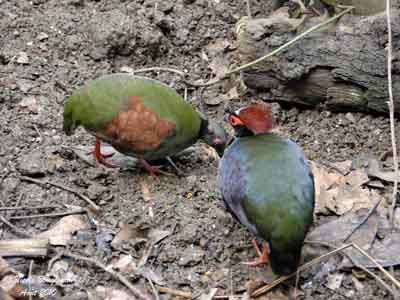
DIET:
The Crested Partridge feeds on seeds, large fruits and invertebrates such as large beetles, wood ants of genus “formica”, and also small molluscs.
As numerous Galliformes, this species forages by scratching and picking among the leaf-litter.
PROTECTION / THREATS / STATUS:
The Crested Partridge is vulnerable and classified as NEAR THREATENED.
It was formerly widespread, but it is now scarce in Thailand. In Indonesia, the species is threatened by habitat loss. In the other parts of the range, this partridge is often declining, due to habitat destruction and mainly deforestation, and hunting pressure.
However, the Crested Partridge can be found in several protected areas in some countries. But this species is considered as vulnerable.
